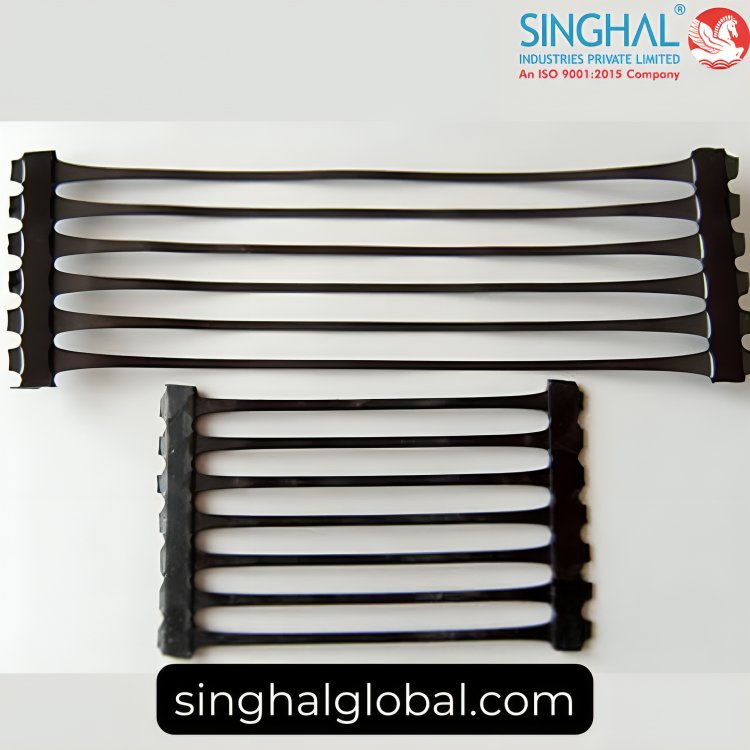Building Tomorrow: Uniaxial Geogrid Technology in Infrastructure Evolution
Explore the future of infrastructure with Uniaxial Geogrids. Revolutionizing construction for sustainable, resilient cities. Learn more now!
Share this Post to earn Money ( Upto ₹100 per 1000 Views )

The world's infrastructure is constantly evolving, facing the challenge of supporting a growing population and enduring harsher environmental conditions. Traditional construction methods are often inadequate, requiring innovative solutions to ensure long-lasting, sustainable infrastructure. Uniaxial geogrids are emerging as a game-changer in this arena, offering a robust and cost-effective approach to building a stronger tomorrow.
Uniaxial Geogrids: A Reinforcement Revolution
Uniaxial geogrids are high-strength polymeric grids with superior tensile properties in one primary direction. These grids, manufactured from polymers like polypropylene (PP) – a popular choice in India due to its affordability and strength – are used to reinforce soil, rock, and other construction materials. They achieve this by:
1. Interlocking with surrounding materials: The grid's openings allow for the passage of soil particles, creating a mechanical interlock that enhances the overall strength and stability of the reinforced mass.
2. Stress transfer: Loads are efficiently distributed across a wider area, reducing stress concentrations and preventing localized failures.
3. Confinement: Uniaxial geogrids confine surrounding soil particles, preventing them from moving laterally and improving the material's shear strength.
Uniaxial Geogrids in Action: Applications for a Resilient Future
The versatility of uniaxial geogrids makes them applicable in a wide range of infrastructure projects, including:
1. Road construction: Uniaxial geogrids placed beneath the road pavement distribute traffic loads more evenly, reducing fatigue cracking and extending the road's lifespan. They also improve subgrade stability, preventing rutting and potholes.
2. Soil reinforcement structures: Slopes, embankments, and retaining walls can be significantly reinforced with uniaxial geogrids. These grids increase the bearing capacity of the soil, allowing steeper slopes and taller structures with improved stability.
3. Foundation stabilization: Uniaxial geogrids placed on soft soils can create a stable platform for foundations, reducing settlement and improving the overall structural integrity of buildings and other structures.
4. Landfills: Uniaxial geogrids can be used in landfill construction to improve drainage, enhance containment liners, and increase the overall stability of the landfill.
Benefits of Uniaxial Geogrids: Building a Sustainable Future
Uniaxial geogrids offer several advantages over traditional construction methods, making them a sustainable choice for infrastructure projects:
1. Cost-effectiveness: Uniaxial geogrids are relatively inexpensive compared to alternative reinforcement methods like concrete or steel. They also reduce construction time and labor costs, leading to overall project cost savings.
2. Durability: Made from high-quality polymers, uniaxial geogrids are resistant to corrosion, degradation, and harsh environmental conditions, ensuring a long service life.
3. Reduced environmental impact: By minimizing the need for additional construction materials like soil or aggregates, uniaxial geogrids contribute to a more sustainable construction process.
4. Improved performance: Uniaxial geogrids demonstrably enhance the strength, stability, and longevity of infrastructure projects.
Finding the Right Uniaxial Geogrid for Your Project:
With a growing number of Uniaxial geogrid manufacturers in India, selecting the right product for your project requires careful consideration. Here are some key factors to keep in mind:
1. Project requirements: The specific application, such as road construction or slope reinforcement, will determine the required geogrid properties like strength, aperture size, and rib profile.
2. Geogrid properties: Geogrid manufacturers typically provide data sheets outlining the product's tensile strength, elongation at break, and other relevant properties. Ensure these properties meet your project's specific needs.
3. Quality and reputation: Choose a reputable uniaxial geogrid manufacturer known for its commitment to quality control and adherence to industry standards.
Uniaxial Geogrid Price (uniaxial geogrid price):
The Price of uniaxial geogrids can vary depending on several factors, including:
1. Geogrid type: The specific type of geogrid, determined by its strength, aperture size, and rib profile, will influence the price.
2. Roll size: Larger rolls of geogrid are typically priced lower per unit area compared to smaller rolls.
3. Manufacturer and supplier: Prices can vary between manufacturers and suppliers based on their production costs and distribution channels.
Uniaxial Geogrids in India
The Indian infrastructure sector is experiencing phenomenal growth. To meet this demand, the use of innovative technologies like uniaxial geogrids is rapidly increasing. Several manufacturers in India produce high-quality PP geogrid india, catering to the growing needs of the construction industry. Finding the right uniaxial geogrid manufacturer depends on project specifications and budget. It's advisable to research uniaxial geogrid price offerings from various manufacturers to ensure you get the best value for your project.
Conclusion
Uniaxial geogrids represent a significant advancement in infrastructure technology. Their ability to reinforce soil, distribute loads, and improve drainage makes them invaluable tools for building stronger, more durable, and cost-effective infrastructure projects. As India continues its infrastructure development journey, uniaxial geogrids are poised to play a pivotal role in building a sustainable future.
FAQs(Frequently Asked Questions)
Q1. What are the different types of uniaxial geogrids?
A1. Uniaxial geogrids come in various configurations based on material (polypropylene, polyester), rib shape (flat, triangular), and aperture size (opening between ribs). The optimal choice depends on the specific application.
Q2. How are uniaxial geogrids installed?
A2. Uniaxial geogrids are typically rolled out and mechanically stretched over the prepared subgrade before being backfilled with soil or aggregate.
Q3. What are the environmental benefits of using uniaxial geogrids?
A3. By reducing the need for thicker base materials and enhancing soil stability, uniaxial geogrids can contribute to sustainable construction practices.

 SinghalIndustriesPvtLtd
SinghalIndustriesPvtLtd 




